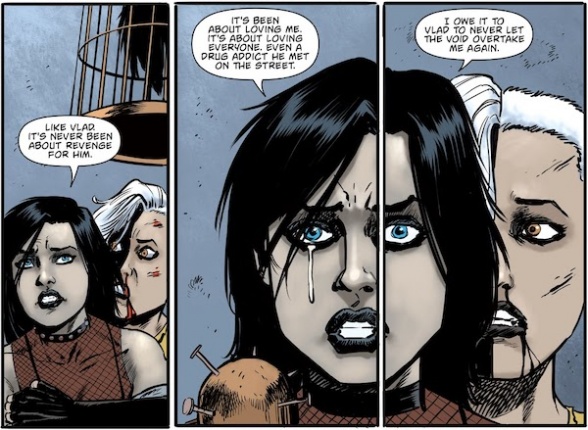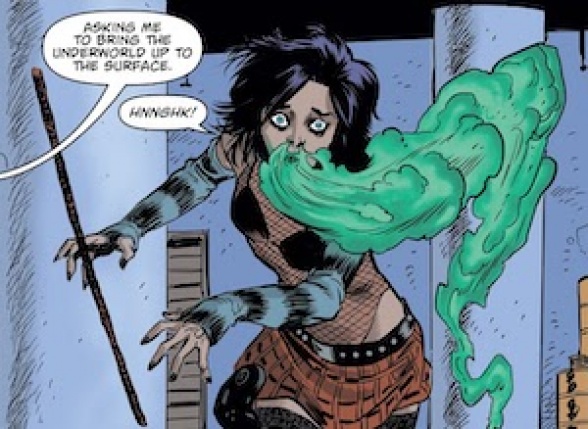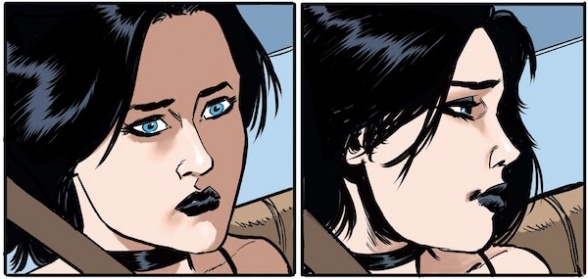Welcome to Butcher’s Block, our “Hack/Slash” annotation. Today we’ll be going over the third and fourth installments of “The Crow: Hack/Slash.”
As a note: unlike some other analyses, this one will not skimp on spoilers, though it will still attempt to be new reader friendly by way of bringing up past information.
Furthermore, for sake of clarity: “Hack/Slash” is a mature comic book series. As such, many images may not be suitable for younger audiences, and quotations and/or panels may include liberal curses and mature content such as profanity, violence, or sexual imagery.
New Concepts
Two concepts brought up in “The Crow: Hack/Slash” #3 and #4 can be summarized by a monologue by Cassandra “Cassie” Hack in “Hack/Slash: The Series” #18 from November 2008. Rather than repeat certain elements of it, it seems most prudent to write it all out first.
“I was pissed at my mom. Pissed at myself. I turned myself into a weapon. A bullet aimed at my mom, which would eventually come around and get me, too. […]There’s nothing else for me to do this for. No one but me. I don’t even know who I am. All that’s left is the weapon.”
Identity

Maintaining a sense of identity, be it through violence or peace, can be troubling for many people in reality or fiction, and “Hack/Slash” is no exception.
In Cassie’s case, it is often difficult to identify who she is without a hunt, given her multiple untreated mental disorders on top of her lifestyle in general. Even when she claims to be happy by herself without her “job” as in the beginning of “Hack/Slash Resurrection,” every mention is so direct that it is blatantly obvious that she is not fully satisfied. Only once she took up slasher slaying once more with Vlad did she seem to approach catharsis. Even Hack’s one-time partner Delroy in “Hack/Slash: Son of Samhain” noted that she seemed to miss the hunt when she tried to retire. She may hate herself for her own reliance on violence at times, but the point remains that she doesn’t seem capable of being a more peaceful person in general.
In the case of Marcus Grieves, there is a different problem. He was at home in his identity as a homosexual drag queen, but seeing as he was living in 1986, said identity was not tolerated nearly as much, resulting in his and his lover’s murders by a gang of homophobes. His entire mission is an attempt to prevent losing his sense of identity, as he needs to return Angeles Cero to her grave in order to return to his love Aiden in Heaven.
Emptiness of Vengeance

By and large, revenge is one of the most prominent motivating factors for assailants in “Hack/Slash.” Vengeful killing was essential to slashers in particular, with the focus of their rage often starting as people directly related to or otherwise similar to those who caused their death in the first place, or are harming those they cared for. Even Cassie Hack herself was initially motivated by loathing of slashers, and only began helping for more benevolent reasons once the target of her hate was, as far as she could tell, well and truly dead.
However, vengeance isn’t all it’s cracked up to be. Once the hated being is gone, there is often no sense of satisfaction, no peace of mind, no calm. Revenge may have been served, but there is no solace to the victims at all beyond a lack of further violence. And what if the targets had no means or methods to cause further harm in the first place? What is left is no justice at all, no catharsis, no happiness, just an empty feeling. For Cassie in particular, the result was virtual catatonia for hours on end once she realized she had no further retribution to provide to her mother.
After all, the realization of the end of a successful rampage could just not be good enough. On the one hand, the perpetrator seeking revenge could realize that the ends did not justify all that they went through to get to the means, and that they lost far more than they gained in the process of the hunt, or even that the one they sought vengeance for would not have approved of what they had done in the process. On the other hand, they could be left without a sense of purpose. They completed their mission, and are left a burning question: “So what do I do now?” Furthermore, as shown in “The Crow: Hack/Slash” #4, getting revenge does not actually solve the problem that led to the quest in the first place: it takes something more benevolent and altruistic to save Vlad’s life, and the actual act of killing itself did nothing at all, with him being in deteriorating condition until the aforementioned benevolent, altruistic act.
Continued belowMany slashers kept going after their targets were long dead, mainly because of their existence as revenants and the black ambrosia itself. Due to this unnatural state, rather than learning about said emptiness, they degenerate in their motivations, broadening the category of people who they kill rather than making an attempt to stop, such as in the case of Angela “Acid Angel” Cicero and Bobby Brunswick.
Those who are more cognizant of the ultimate goal seem to be much more capable of at least learning from the experience. In Cassie’s case, she tried to retire, but upon realizing that she is the only one properly equipped with the knowledge to fight slashers, she decided to instead fight to protect others from their activities, rather than the primary reason of her own self-loathing, though she does at times, such as in this miniseries, backslide into revenge again. Meanwhile, Angeles Cero seems to actually consider stopping her massacres by the end of “The Crow: Hack/Slash” #3 once she believes she has succeeded in her quest to kill everyone even remotely connected to her sister’s death, and only continues onward due to the more overt manipulations of Urban DK, who is clearly the one pulling the strings and seems to be the reason behind her continued existence as a Crow in the first place, as implied as early as the first issue of the miniseries and fully revealed in these latter two issues.
Mortal Dangers

“Ah, my dear Cassandra Hack. You’ve spent too much time facing those simple-minded muerto vivante. ‘Slashers.’ You’ve come to underestimate the living that despise the living. You have forgotten our aptitude for resourcefulness. And our capacity for treachery.” – Pedro Miramontes, “Hack/Slash / Nailbiter”
While slashers and other supernatural creatures are very common in “Hack/Slash,” they are not always the ones in charge of the plot at work. Several times, a mortal individual (though not necessarily one without any supernatural elements whatsoever) is the real mastermind behind a plot who needs to be taken down. While the physical danger may be less, and the person more easily killed (comparatively), such a difference often remains a shock when it does happen, or at least is not planned for by the slasher bashers.
At times, the slasher (as it is more often used for slashers over other beings) is controlled by or otherwise reanimated by a witch or other user of magic, or even through more scientific means. Examples include Laura Lochs’s control over Niles “Father Wrath” Rafferty, Liberty “Libby” Lochs’s less effective version of something similar over Julian “Mosaic Man” Gallo, and Andrew Rodin’s use of the monstrous “Sons of Man” in the arc of the same name. Sometimes, there is no supernatural element to the conflict at all, such as in the case of Pedro Miramontes (quoted above).
With Urban DK, there does seem to be some mysticism at work, but in a different form than the ones used by the Lochs sisters. As hinted at as early as the first issue of “The Crow: Hack/Slash,” he seems to be using some form of ritual magic to bind the mystical Crow in its cage and prevent it from allowing Angeles Cero to move on. To what end is unclear, perhaps using her as some form of attack dog perpetually, but his decision to tell Angeles not to rest despite getting her revenge and much more, on top of his apparent goal to do something to the Crow itself, paints him in the light of one of those subversive antagonists.
Relationship between Revenge and Love

The obsessive, revenge-fueled assailants work into a relationship with those who operate on more altruistic principles, most notably love, albeit not necessarily a dichotomous one. There is something of a blurred line at times, especially when the killer is not an actual slasher.
Revenge may appear to be a justifiable goal, but is rather self-centered, as by the end all that is often achieved is a resemblance toward peace for the one who achieved such an end, rather than the one avenged (see above under “Emptiness of Vengeance” for more on that). Many slashers operate that way, especially as they degenerate into losing their ability to understand love and developing a hatred of the concept.
Continued belowThose fueled by love of another, be it familial, platonic, or romantic, tend to attack others in defense of those they care about. They can be selfless, and at times can even be bargained with to get them to stop or at least slow down enough to be eliminated or otherwise temporarily neutralized. Vlad is one such person, willing to help anyone he can while being a true hero, and even his moments of rage are brought on by Cassie or others he cares about, even those who he barely knows, being hurt. Another is Marcus Grieves, who, after fulfilling his mission as a Crow through revenge, was sent back to help someone else pass on and return to his lover Aiden in Heaven once more.
The blurry end of the line comes when someone is achieving revenge for a loved one and has to decide on which is the correct path. The Crows themselves are reborn incarnations of this very concept, being brought back for the sake of revenge in the name of love, with the shift from one to the other being a major part of the plot for Angeles Cero in “The Crow: Hack/Slash” #4. Despite being a slasher, Delilah “Lunch Lady” Hack acted out of her own twisted idea of love in killing anyone she saw as hurting her little girl, though it eventually turned into straight up vengeance as time went on, especially after her temporary resurrection by Dr. Hebert West. The aforementioned Libby Lochs acted out of love for her sister Laura to avenge her death, but realized how she had been tricked a few moments too late and appeared to have foresworn both concepts by the time of the “Murder Messiah” annual. Cassie also has had her own run-ins with the idea of love and revenge, including beating a serial killer who was threatening a girl she loved half to death with her bare hands, rescuing friends while administering “good old-fashioned, bloody, nasty goddamn revenge,” and her dark path through this very miniseries that she professes to give up at the end (though time will tell if that sticks).
New Issues
The Crow: Hack/Slash #3
Outside of reaching the protagonists’ darkest hour and the revelation of Marcus’s past (including why he was unfamiliar with some modern technology), “The Crow: Hack/Slash” #3 delved into another element that harken back to earlier stories.

Urban DK’s use of gaseous weaponry to subdue Cassie Hack may remind returning readers of Papa Sugar, the voodoo salesman from New Orleans she met during her brief partnership with Charles Lee “Chucky” Ray. There, the gas was used to paralyze her but leave her conscious all the while until an antidote was administered, for reasons best left unsaid. The same toxin was later used as part of a gambit to foil the plot of Laura Lochs by paralyzing her for a body swap akin to the one that turned Ray into Chucky in the first place.
This particular gas does not seem to have the same effect, more being a general concoction to cause a coughing fit, but the similarity is still rather noticeable.
The Crow: Hack/Slash #4
As it turns out, Urban DK’s plan is to disperse the essence of the Crow between multiple crow eggs, creating more crows for “the justice of anyone who’ll pay,” meaning he would essentially be creating a revenge-based protection racket for himself. Furthermore, while we had not seen him at work for the most part, it seems his shamanism is absolutely not to be trifled with, to the point of being capable of removing the essence of the Crow from the reborn, as well as utilizing that very same black essence to heal himself when injured by taking advantage of the Crow’s connection to healing and rebirth.

It takes Cassie convincing Angeles Cero of the pointlessness of continuous, unending revenge to put an end to Urban DK’s plan when he is about to use Marcus, in the place of Angeles, to fulfill his aims. Even then, Angeles seemed willing to go through with it at first in spite of knowing that her sister Lilith would have never gone as far as she had in the name of “justice.” Only with an understanding that going through with something in order to help someone or be with someone, rather than just an attempt to attain self-satisfaction (as she had turned to by helping with this last plot instead of just going back to her grave by letting the Crow free), was the way to a true sense of justice for the more villainous Crow to finally let Cassie break the cage holding the Crow entity itself, which resulted in both Urban DK’s gruesome death by eye gouging and Angeles subsequently accepting her own death.
Continued belowUltimately, with Vlad revived through the sacrifice of Marcus Grieves (who gave up the chance to go back to Heaven and be with Aiden in order to “balance life and death”), the two hunters are on the road again. Vlad has only one question as he drives: “What will we do now, Cassandra?”

What indeed? We will see what comes next with the “Hack/Slash 15th Anniversary Celebration” from Image Comics in December, with multiple parts to it even beyond the new narrative elements themselves.
Want to know more about the pieces of the lore and particular material discussed, or other elements about the epic as a whole? Feel free to ask away in the comments below.






